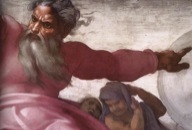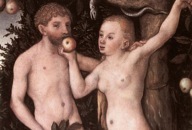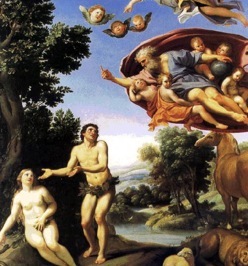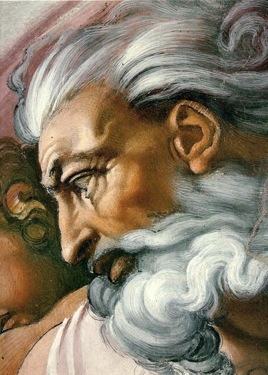CReation in Genesis


CReation in Genesis




Genesis begins with a cosmogony, that is, with an account of the creation of the world and everything in it. Elements of the Genesis story of creation are similar to Near Eastern cosmogonies and theogonies and may have been acquired at one or more of several points in Hebrew history. The most important, and perhaps earliest of these contacts may have come when Hebrews came into proximity with the Bronze Age city of Ugarit, on the Mediterranean coast of what is today Syria. Ugarit is a candidate for contact primarily because extensive excavation of that site has unearthed a wealth of written texts that include myths and other religious material in a number of languages. There might have been other cosmopolitan communities along the Mediterranean coast with similar collections of texts that the Hebrews either contacted, or, indeed conquered, before the compilation of Genesis took place.
The Genesis cosmogony is essentially an ex nihilo creation story. In the beginning there is only God. There is no other matter in the universe. The creation takes place over the course of one week (six days, actually), during which the world takes form and shape, and the things within it are created.
 Day 1: God creates light and divides the light from the darkness, and "day" and "night" are named.
Day 1: God creates light and divides the light from the darkness, and "day" and "night" are named.
 Day 2: God creates the firmament and divides the waters above from the waters below.
Day 2: God creates the firmament and divides the waters above from the waters below.
 Day 3: God creates "earth" and "sea." God commands the earth to bring forth grass, plants, and fruit-bearing trees.
Day 3: God creates "earth" and "sea." God commands the earth to bring forth grass, plants, and fruit-bearing trees.
 Day 4: God creates lights in the heavens to separate light from darkness and to mark days, seasons and years. Two great lights are made (most likely the Sun and Moon, but not named), and the stars.
Day 4: God creates lights in the heavens to separate light from darkness and to mark days, seasons and years. Two great lights are made (most likely the Sun and Moon, but not named), and the stars.
 Day 5: God creates birds and sea creatures, and commands them to be fruitful and multiply.
Day 5: God creates birds and sea creatures, and commands them to be fruitful and multiply.
 Day 6: God makes wild beasts, livestock and reptiles and then creates Man and Woman in His "image" and "likeness." They are told to "be fruitful, and multiply, and fill the earth, and subdue it." God looks upon His finished work and declares it "very good."
Day 6: God makes wild beasts, livestock and reptiles and then creates Man and Woman in His "image" and "likeness." They are told to "be fruitful, and multiply, and fill the earth, and subdue it." God looks upon His finished work and declares it "very good."
 Day 7: God rests from His work, and blesses and sanctifies the seventh day.
Day 7: God rests from His work, and blesses and sanctifies the seventh day.
A “second creation,”called the Eden Narrative appears in chapter 2 of Genesis. It creates a problem for Fundamentalists because the details of creation are different from the first narrative. Some scholars argue that the second narrative was essentially a second story added by a different set of scribes without much attention to the first story. But, a number of scholars, among them Robert Alter, argue that, from a literary point of view, there is a continuity between the first and second story. In the first narrative, God is a distant, daunting and unaccountable deity. In the second narrative, the author makes Him a more “human,” more approachable deity. Whereas the first narrative focuses on the creation of the cosmos, the second narrative narrows its focus almost immediately to the creation of the first humans, Adam and Eve, and creates an intimate relationship between God and man.
 Before any plant was in the earth, God creates Adam and gives him life.
Before any plant was in the earth, God creates Adam and gives him life.
 Then He creates a garden on the earth, Eden, which is to be the habitat of man.
Then He creates a garden on the earth, Eden, which is to be the habitat of man.
 God then places “the tree of life also in the midst of the garden, and the tree of knowledge of good and evil.” He tells Adam that he may eat the fruit of every tree but this one.
God then places “the tree of life also in the midst of the garden, and the tree of knowledge of good and evil.” He tells Adam that he may eat the fruit of every tree but this one.
 Seeing that Adam has no mate, God creates Eve from one of Adam’s ribs. “And they were both naked, the man and his wife, and were not ashamed. “
Seeing that Adam has no mate, God creates Eve from one of Adam’s ribs. “And they were both naked, the man and his wife, and were not ashamed. “
 The second narrative then covers Eve’s temptation, the fall of man and the expulsion from the Garden.
The second narrative then covers Eve’s temptation, the fall of man and the expulsion from the Garden.
 It ends with the story of Cain and Able, and the “generations” of Adam.
It ends with the story of Cain and Able, and the “generations” of Adam.
The second narrative forms a bridge between the cosmogony and the remaining stories within Genesis and the Torah. The narrative introduces the human element of Creation, the “fruitfulness” of humans, and both the wrath of God and His forgiveness for the ongoing and unavoidable error and sinfulness of humans. These are ongoing themes within the Bible.
A couple of major differences between the Creation narratives in Genesis and other creation stories are evident. The first is that the Hebrew version contains no theogony. This marks a theological revolution. There is no need for a theogony because, for the Hebrews of the age when the Torah was compiled, there was only one god and He had existed forever. A complicated theogony was therefore unnecessary. Compare this to the series of generations of gods and other semi-divine beings in the Enuma Elish and Hesiod’s Theogony. A second difference has to do with the purpose of Creation. We get no clear explanation of why the Earth was created in most other accounts of the creation of the world. In Genesis, the explanation emerges that God created the world, the seas, the land, the plants and animals as a stage and to provide for the needs of humans. In Genesis, man is the glory of God’s creation; the world is his oyster. In the Enuma Elish, humans are created as labor saving devices, essentially slaves, whose only function was to serve the gods. Finally, in the Theogony, we are left wondering why the gods actually bothered.
In the beginning God created the heaven and the earth. And the earth was without form, and void; and darkness was upon the face of the deep. And the Spirit of God moved upon the face of the waters.
And God said, Let there be light: and there was light.
And God saw the light, that it was good...

Creation: Genesis 1-5

















Detail from the Sistine Chapel by Michelangelo.


















